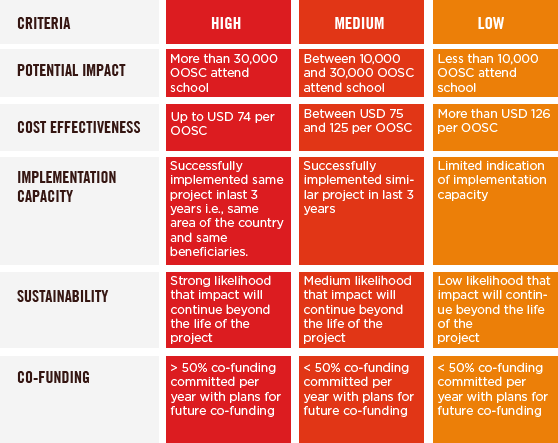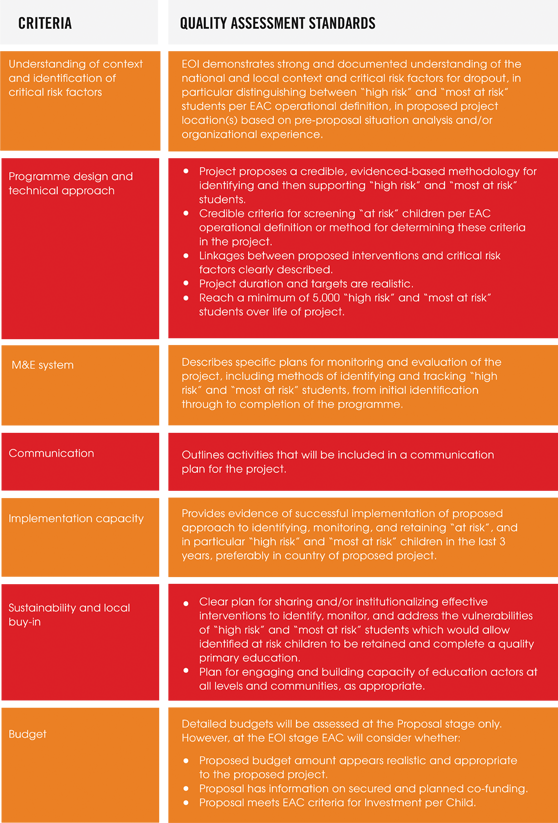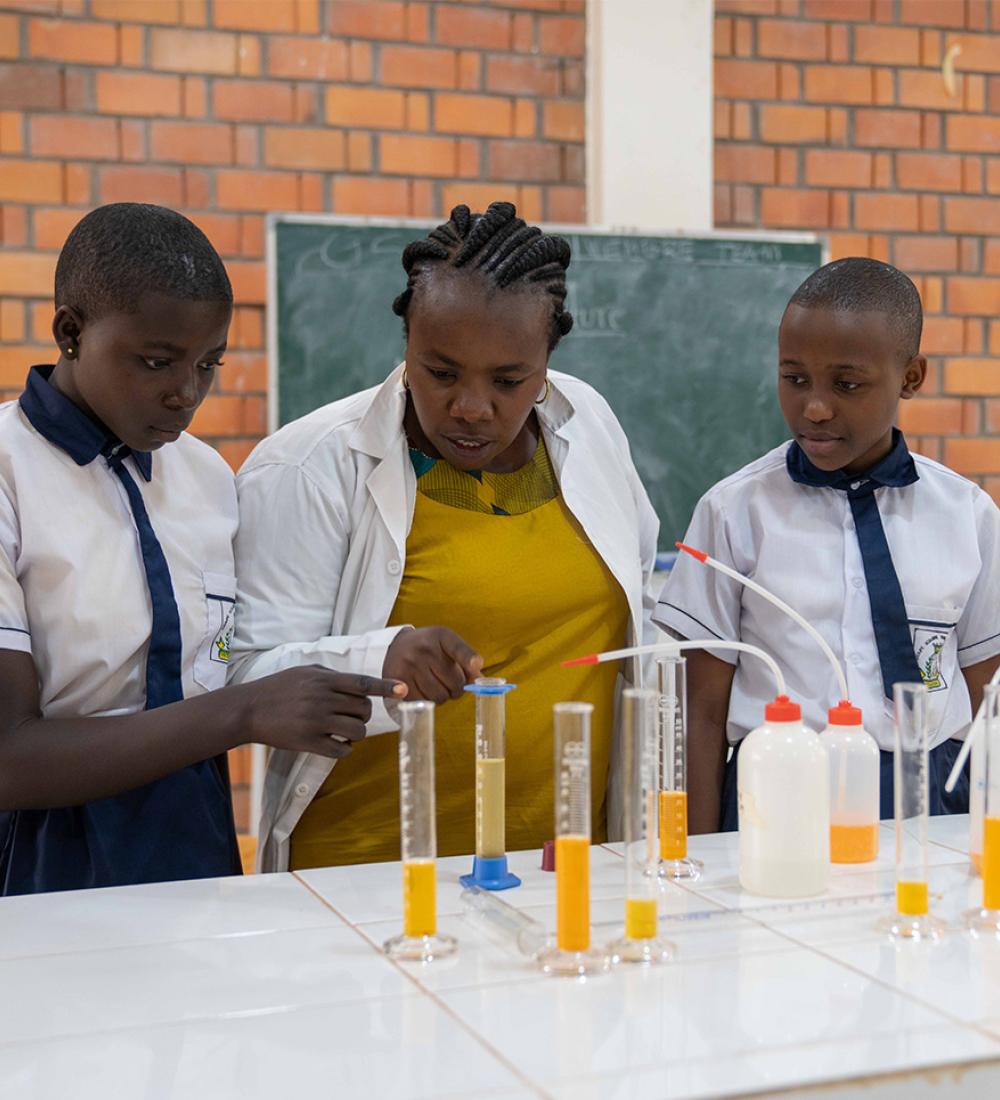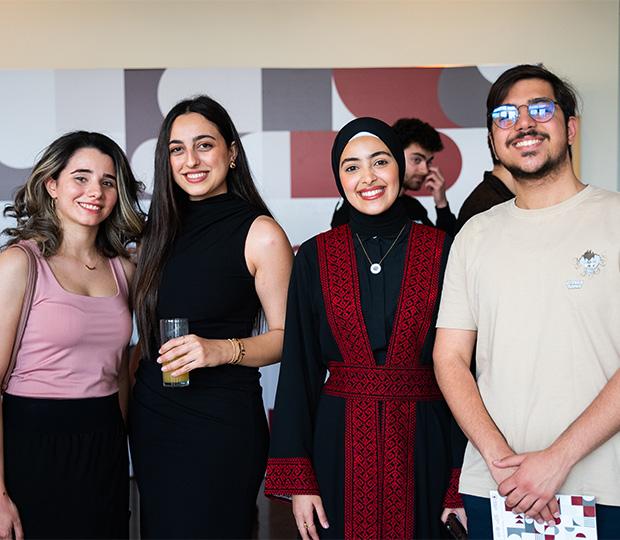Educate A Child
There are also organisations with expertise in raising awareness of issues, developing wide-spread networks and mobilising resources. It is only by bringing together the combined knowledge, skills, and experiences of these organisations that we will be able to help millions of children realise their basic human right of receiving an education.
EAC needs many kinds of partners to accelerate the identification, enrolment and completion of a quality primary education for a significant number of out of school children.
We are looking for Strategic, Implementing, Advocacy and Resource partners from:
- National or international education, development and humanitarian organisations that have national, regional or global reach;
- Organisations or people that have succeeded in advocating for education on a large scale;
- Programs and agencies that have experience implementing primary education activities in support of out of school children who have never gone to school and those who have dropped out of school;
- Organisations or people that have experience in education provision in fragile, conflict-affected and disaster situations;
- Programs or agencies that have demonstrated their ability to engage with hard-to-reach populations;
- Organisations, programs and people that have proven capacity to mobilise additional resources in support of primary education; and
- Agencies and people that have tested different methods of and approaches to reaching out of school children with education, including, but not limited to, emerging technologies.
If your organisation shares EAC’s vision of a world where every individual has the opportunity to learn through a quality primary education, and is interested in becoming an EAC partner, please read more about our types of partnership and follow the guidelines for submitting your expression of interest for the type of partnership your organisation is seeking.
Potential Partner Inquiry Submission Guidelines
Should you, after assessing EAC criteria against your proposed project, feel that we are mutually aligned, please download and complete the potential partner inquiry form, which is available here. The form should be submitted via email to eacpartners@eaa.org.qa. Upon review and if accepted, you will be invited to make all subsequent Expression of Interest (EOI) submissions and queries directly through EAA’s Management Information System (MIS).
EAC has two EOI submission periods each year
- The first submission window will be during the first quarter of the year, 1 January through 31 March
- The second submission window will be during the 3rd quarter of the year, 1 July through 30 September
Potential partners can expect feedback on an EOI submission in the subsequent quarter. That is:
Request for proposal (RFP)
EOI feedback will indicate if the EOI was successful or not.
Potential partners submitting successful EOIs, will receive a RFP in either the second or fourth quarter of the year (dependent on which quarter the EOI was submitted). The RFP will include a specific timeline for the submission of a proposal. (This is usually 6 weeks)
- 1 April through 30 June if the EOI was submitted in the first quarter, and
- 1 October through 31 December if the EOI was submitted in the third quarter
EOI submission guidelines
Please review the below EOI evaluation criteria thoroughly and keep in mind that:
- All EOIs should be submitted in English
- All currency amounts entered in the EOI should be shown in USD ($) only
- EAC will accept limited three-country applications (not to exceed 3 countries for each multi-country application) that provide solid technical, implementation and financial rationale for it. The applicant must demonstrate:
- Capacity to implement, monitor, and report project effectively in the proposed countries, including a presence each country;
- Ability to engage in and receive approval of each partner country Ministry of Education in the implementation of the project;
- Ability to show measurable impact in each country;
- Efficiencies that will be gained in the multi-country proposal;
- Ability to develop a plan to engage stakeholders in the visibility and sustainability of the project; and
- Preferably, meeting EAC minimum number of OOSC in each country.
Expressions of Interest evaluation criteria – OOSC at the Primary Level:


Potential projects should be rated as either high or medium in all criteria to be considered for support.
EOI Submission Guidelines for Primary OOSC in Small Island Developing States (SIDS)
Please review the below EOI evaluation criteria thoroughly and keep in mind that:
- All EOIs should be submitted in English;
- Proposed projects should demonstrate a commitment to educating out of school children affected by climate change;
- All currency amounts entered in the EOI should be shown in USD ($) only.
Expressions of Interest for SIDS addressing climate change will be appraised according to the criteria below:
|
CRITERIA |
QUALITY ASSESSMENT STANDARDS |
|
Understanding of context and identification of barriers |
EOI demonstrates strong and documented understanding of the national and local context and barriers to education, in proposed project location(s) based on pre-proposal situation analysis and/or organisational experience. Demonstrates an understanding of the impact of climate change on education and the barriers it creates.
|
|
Programme design and technical approach |
The proposed project has:
|
|
Implementation capacity |
Provides evidence of the potential partner’s experience in having had a successful implementation of proposed approach to identifying, enrolling, and retaining OOSC in a quality education programme in the last 3 years, preferably in country of proposed project. |
|
Sustainability and local buy-in |
The EOI shows:
|
|
M&E system |
Describes specific plans for monitoring and evaluation of the project, including methods of enrolling, retaining and reporting on OOSC, from initial identification through to completion of the programme. |
| Budget
|
Detailed budgets will be assessed at the Proposal stage only. However, at the EOI stage EAC will consider whether:
|
EOI guidelines – At Risk of dropping out of primary education
In 2018, EAC introduced a new initiative under its strategic objective to: Ensure inclusive and equitable access to primary education for out of school children, that will support children who are considered to be “at risk” of dropping out of primary education. EAC’s target population is the more disadvantaged and marginalized children within school/communities, those “at high risk” and those “at most risk” of dropping out.
At Risk EOI Submission Guidelines
- All EOIs should be submitted in English
- All currency amounts entered in the EOI should be shown in USD ($) only
Expressions of Interest evaluation criteria – At risk of dropping out of primary education:


Potential projects should strongly align to all criteria to be considered for support.
EAC has two EOI submission periods each year
- The first submission window will be during the first quarter of the year, 1 January through 31 March
- The second submission window will be during the 3rd quarter of the year, 1 July through 30 September
Potential partners can expect feedback on an EOI submission in the subsequent quarter. That is:
Request for proposal (RFP)
EOI feedback will indicate if the EOI was successful or not.
Potential partners submitting successful EOIs, will receive a RFP in either the second or fourth quarter of the year (dependent on which quarter the EOI was submitted). The RFP will include a specific timeline for the submission of a proposal. (This is usually 6 weeks)
- 1 April through 30 June if the EOI was submitted in the first quarter, and
- 1 October through 31 December if the EOI was submitted in the third quarter













